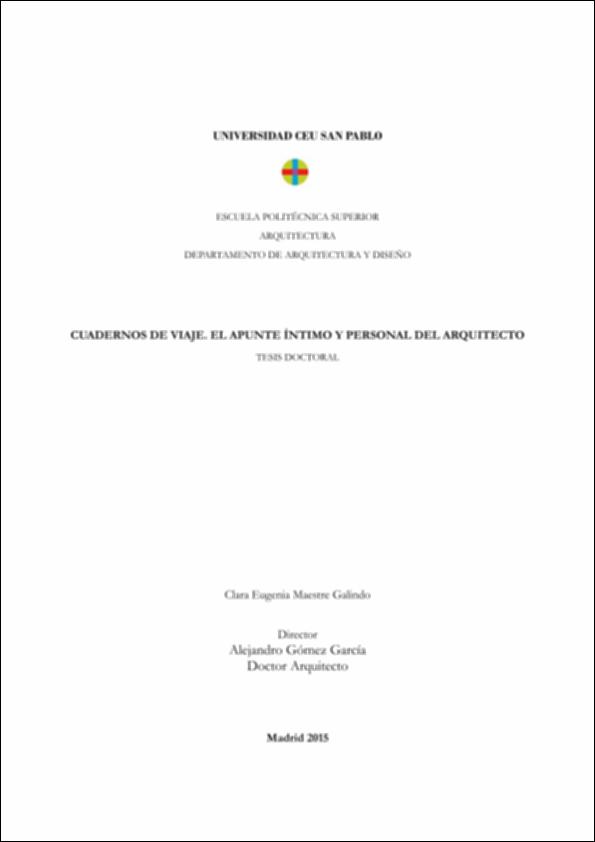Please use this identifier to cite or link to this item:
http://hdl.handle.net/10637/15782Cuadernos de viaje: el apunte íntimo y personal del arquitecto
| Title: | Cuadernos de viaje: el apunte íntimo y personal del arquitecto |
| Authors : | Maestre Galindo, Clara Eugenia |
| Keywords: | Arquitectura |
| Citation: | Maestre Galindo, Clara Eugenia (2015). Cuadernos de viaje. El apunte íntimo y personal del arquitecto. 2015. Tesis Doctoral. Universidad CEU San Pablo |
| Abstract: | If we were to see life as a journey, these travel notes could be the drafts of fragments of time. Frozen in time, the life drawings nature crystalizing the moments he experiences. These drawings are straightforward and direct graphic expressions of small portions of the architect’s thoughts. They therefore also convey his wishes and desires, his curiosity and quests as well as his surprise, disappointment or discovery. We have selected ten twentieth century architects, prominent authors of travel notes: John Ruskin, Charles Rennie Mackintosh, Erik Gunnar Asplund, Le Corbusier, Alvar Aalto, Louis I. Kahn, Arne Jacobsen, Alvaro Siza, Enric Miralles and Michael Graves. All of them were pursuing some goal when travelling but weren’t always aware of it in advance. They were seeking answers but the fact is that their questions were more relevant than the answers they sought. And as such it is expressed in their drawings. The profession of the authors has always been present during their travels even if it was not considered in the course of the study. The graphic skills acquired during their academic education qualified them to use a common language. The prior and initial premise of the study is not to consider the authors’ professional work which has allowed us to make a different assessment by keeping their best known architectural work at a distance and approach them in a quieter and more reserved way than is customary. Their notes allow us to discover through subtle and not always obvious, folds some signs of their deepest thoughts. The calm observation of their drawings, the interweaving of them all, has led to the discovery of a rare kind of unexpected autobiography, probably outside of the intention of their authors. The decision to study their travel notes grouped by subjects instead of by author has allowed for a comparative analysis. We have studied and analyzed the distances they used to approach their models, the media and the various techniques they used to draw buildings, cities, landscapes or local traditions as well as the portraits of those closest to them. The exploration of these travel notes has allowed us to approach–its authors a bit more- in an intimate and personal way, revealing to us in our path their own discovery. Suponiendo que vivir es realizar un viaje a través del tiempo, podríamos considerar que los apuntes de viaje son retazos de tiempo dibujados. Detenidos en el tiempo, los bocetos del natural cristalizan momentos de la vida de los autores. Directos, los apuntes del natural expresan gráficamente pequeñas porciones del pensamiento de la mente del arquitecto. Transmiten sus deseos y anhelos, la curiosidad y la búsqueda, a la vez que sus sorpresas, desengaños o hallazgos. Se seleccionaron diez autores del siglo XX, autores destacados de apuntes de viaje, John Ruskin, Charles Rennie Mackintosh, Erik Gunnar Asplund, Le Corbusier, Alvar Aalto, Louis I. Kahn, Arne Jacobsen, Álvaro Siza, Enric Miralles y Michael Graves. Todos los autores perseguían algún objetivo en sus viajes aunque no siempre fuera conocido de antemano. Intentaban encontrar respuestas pero, la realidad es que fueron más relevantes las cuestiones que se plantearon que las respuestas que hallaron. Sus dibujos así lo expresan. Aunque en el trascurso del trabajo no haya sido considerada, siempre ha estado presente la profesión de los autores durante el viaje. Sus habilidades gráficas, adquiridas durante la formación académica, les capacitaban para emplear un lenguaje común. La decisión de no considerar la obra profesional de los autores, premisa previa e inicial del estudio, ha permitido realizar una valoración diferente al alejar la faceta más conocida del arquitecto para acercarnos a ellos de una forma algo más reservada de la acostumbrada. Sus apuntes nos han dejado descubrir a través de sutiles pliegues, no siempre evidentes, algún que otro resquicio de sus más hondos pensamientos. Observar calmadamente sus dibujos, entretejiéndolos todos ellos, ha propiciado el descubrimiento de una especie de rara autobiografía inesperada, ajena probablemente a la intención del autor. Ha sido determinante la decisión de estudiar sus apuntes de viaje, no agrupados por autor, sino por temas que permitieran un análisis comparado. Se han estudiado y analizado las distancias a las que se aproximaron a sus modelos, los soportes y técnicas variadas que emplearon al dibujar la arquitectura, la ciudad, el paisaje o la tradición, rodeados y los retratos de personas durante sus vidas. Explorar estos apuntes de viaje ha permitido acercarnos un poco más a ellos, sus autores, de un modo íntimo y personal, desvelando durante nuestro camino su propio descubrimiento. |
| Description: | Tesis CEINDO, Universidad San Pablo CEU, Programa de doctorado "Ciudad y patrimonio. Recuperación y dinamización de tejidos urbanos". Leída el 10 de diciembre de 2015 |
| Director(s): | Gómez García, Alejandro |
| Defense date: | 10-12-2015 |
| URI: | http://hdl.handle.net/10637/15782 |
| Rights : | http://creativecommons.org/licenses/by-nc-nd/4.0/deed.es |
| Issue Date: | 2015 |
| Center : | Universidad San Pablo-CEU |
| Appears in Collections: | Escuela de Politécnica Superior |
Items in DSpace are protected by copyright, with all rights reserved, unless otherwise indicated.


